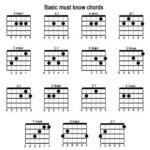Guitar Sizes can vary significantly, from the incredibly small ukulele to the massive jumbo acoustic guitars. Choosing the right size is crucial for comfort, playability, and even the tone of your instrument. This guide will walk you through the different guitar sizes available, from the smallest to the largest, helping you find the perfect match for your needs and preferences.
The Tiny Titan: Ukulele
The ukulele, originating from Hawaii, is a small, four-stringed instrument that’s often considered part of the guitar family. It’s the smallest guitar size you’re likely to encounter regularly.
Ukuleles are exceptionally popular for several reasons. Their small size makes them ideal for:
- Children: Younger players often find full-sized guitars overwhelming, but ukuleles are perfectly proportioned for small hands.
- Travelers: Their portability is unmatched. Ukes are incredibly easy to carry around, making them great for taking on trips.
- Players with Smaller Hands: Adults with smaller hands or those who find standard guitar necks too wide may find the ukulele’s narrower neck more comfortable.
- Unique Sound: Ukuleles produce a bright, cheerful, and trebly tone that is distinct and enjoyable for many styles of music.
However, it’s worth noting that ukuleles are tuned differently from standard guitars (typically G-C-E-A). While a great instrument in its own right, this different tuning can be a consideration for beginners planning to transition to guitar later on. The ukulele’s sound profile is also very bright, lacking the deeper bass tones of larger guitars.
The Best of Both Worlds: Guitarlele
The guitarlele (sometimes spelled guitalele or called a kiki) bridges the gap between the ukulele and the guitar. Slightly larger than a ukulele but still very compact, the guitarlele has six strings and offers a unique blend of portability and guitar-like playability. This makes it one of the most versatile small guitar sizes.
The key advantage of the guitarlele is that it uses standard guitar chord shapes. This is a significant benefit for guitarists looking for a travel-friendly instrument or ukulele players wanting to explore guitar techniques without learning new chord forms.
The use of standard guitar chord shapes is a major advantage, making the guitarlele a highly recommended option over the ukulele for those interested in guitar.
Guitarleles are tuned higher than standard guitars, typically tuned to A-D-G-C-E-A, which is the same tuning as a standard guitar with a capo on the 5th fret. This higher tuning contributes to a brighter tone, similar to a ukulele, but with the added range and versatility of six strings. While the higher pitch can sometimes cause confusion when playing with standard guitars, it also gives the guitarlele a distinctive and pleasing voice.
Stepping Stone Size: Half-Size Guitar
As the name suggests, the half-size guitar is approximately half the size of a full-scale guitar. Among the various guitar sizes, this is a popular choice for young children who are just starting to learn.
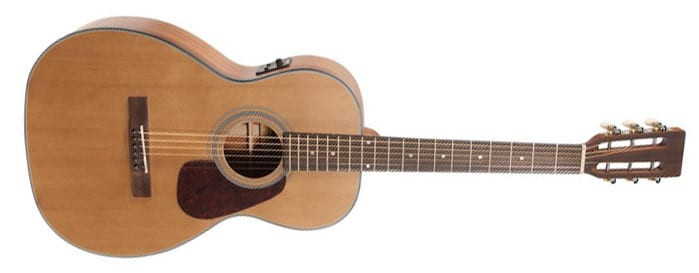 A young child holding a half-size acoustic guitar
A young child holding a half-size acoustic guitar
Both acoustic and electric guitars are available in half-size versions. Crucially, unlike the guitarlele and ukulele, half-size guitars are tuned to standard concert pitch (E-A-D-G-B-e), just like full-size guitars. This makes the transition to larger guitars smoother as children grow.
Half-size guitars are perfect for introducing very young children to the instrument. However, as children grow, typically around age 8, they will likely need to move to a larger size to accommodate their increasing reach and body size. The next step up in guitar sizes is the three-quarter size guitar.
The Tween Transition: Three-Quarter Size Guitar
The three-quarter size guitar is the next step up in guitar sizes from the half-size, and it’s generally considered ideal for children aged 8 to 12. However, three-quarter size guitars aren’t just for kids; they are also excellent for petite adults who find full-size guitars too large and unwieldy.
Like half-size guitars, three-quarter size models are available in both acoustic and electric versions. While both acoustic and electric three-quarter guitars share a similar overall length, electric guitar bodies are typically thinner. This is because electric guitars rely on pickups and amplifiers for sound projection, rather than a large resonant body like acoustic guitars.
Compact Comfort for Adults: Parlor Guitar
The parlor guitar is the smallest of the “full-size” guitars. It’s an excellent option for guitarists seeking a more compact instrument without sacrificing the full tonal range and standard tuning of a larger guitar. For players transitioning from a three-quarter size to a full-size, the parlor guitar offers a comfortable and manageable step.
Parlor guitars are particularly popular with players who find larger guitar shapes like jumbos or dreadnoughts too bulky.
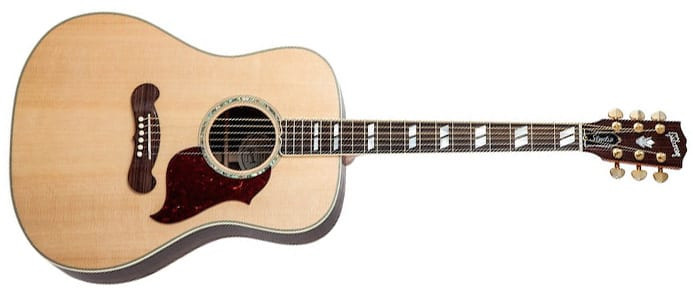 A woman playing a parlor guitar, demonstrating its comfortable size
A woman playing a parlor guitar, demonstrating its comfortable size
Anecdotally, many women guitarists find parlor guitars particularly appealing due to their comfortable size and playability. Parlor guitars sit nicely on the lap, are easy to hold, and offer excellent access to the fretboard. Tonally, parlor guitars are known for their balanced sound, with a rich midrange that sits between the booming bass of larger guitars and the trebly sound of smaller instruments.
Big Sound, Manageable Frame: Auditorium Guitar
Auditorium guitars represent a step up in size from parlor guitars, approaching the dimensions of dreadnoughts but with a curvier and often thinner body profile. This design aims to provide a larger sound while maintaining comfortable playability.
As we move into these larger guitar sizes, we begin to experience a fuller, bassier tone. Auditorium guitars deliver a deeper sound than parlor guitars due to their increased body volume, yet their curved shape often makes them more comfortable to hold and play while seated compared to some other large-bodied guitars.
Auditorium guitars are a great choice for players who desire a robust, full sound but prefer a guitar that’s not as physically imposing as a dreadnought or jumbo.
The Classic Acoustic: Dreadnought Guitar
The dreadnought is arguably the most iconic and “classic” acoustic guitar shape. Its name itself suggests its imposing size and powerful sound. Dreadnoughts are larger than auditorium guitars and are characterized by their square shoulders and deep bodies.
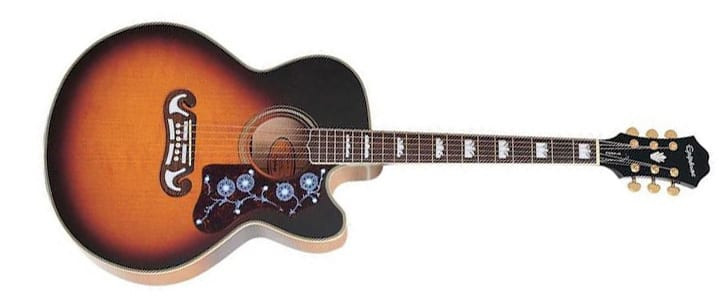 A dreadnought acoustic guitar, showcasing its classic shape and size
A dreadnought acoustic guitar, showcasing its classic shape and size
The large body of a dreadnought allows for significant internal sound reflection, resulting in a powerful and resonant tone with a pronounced low end. This makes dreadnoughts popular for genres like bluegrass, country, and rock, where a strong, driving rhythm and full sound are desired.
While dreadnoughts offer a fantastic, full sound, their larger size can be less comfortable for smaller players or those who prefer a more mid-range or treble-focused tone.
Maximum Volume: Jumbo Guitar
The jumbo guitar is the largest of the standard acoustic guitar sizes. As the name implies, jumbos are big instruments designed to produce a big sound. They boast the largest body volume of all common acoustic guitar shapes, resulting in a warm, booming tone with exceptional projection.
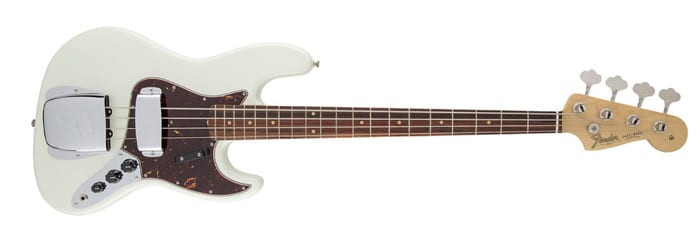 A jumbo acoustic guitar, highlighting its large and rounded body shape
A jumbo acoustic guitar, highlighting its large and rounded body shape
The sheer size of a jumbo guitar translates to a powerful and resonant sound, making them ideal for strumming and vocal accompaniment. However, their bulk can also make them less comfortable to hold and transport, especially for smaller players.
Generally, larger individuals may find jumbo guitars more physically comfortable. However, personal preference and tonal goals are paramount. It’s always recommended to try a guitar before buying to ensure it feels and sounds right for you, regardless of your size. The allure of the jumbo’s massive sound can certainly outweigh its bulk for many guitarists.
Electric Versatility: Full-Size Electric Guitar
Electric guitar sizes are somewhat different from acoustic guitar sizes. While there are half-size and three-quarter size electric guitars, the variations in “full-size” electric guitars are less about body size and more about body style and shape.
Electric guitars produce sound through pickups and amplifiers, not through the resonance of a hollow body. As such, electric guitar bodies are typically solid or semi-hollow and don’t require the large resonant chambers of acoustic guitars. This means there aren’t direct electric equivalents to parlor, auditorium, dreadnought, or jumbo acoustic guitars in terms of body size categories. Instead, “full-size” electric guitars generally refer to instruments with a standard scale length (the vibrating length of the strings).
Electric guitars are often more compact and thinner-bodied than acoustic guitars, even at full-size. However, it’s worth noting that electric guitars can be surprisingly heavy due to the dense woods often used in their construction.
The Low-End Giant: Bass Guitar
While this guide primarily focuses on standard guitar sizes, it’s important to briefly touch upon bass guitar sizes. Bass guitars, designed to play lower frequencies, are naturally larger than standard guitars.
The Fender Precision Bass is perhaps the most iconic bass guitar and exemplifies the typical size of a full-scale bass. However, like standard guitars, bass guitars also come in smaller sizes, including half-size, three-quarter size, and short-scale versions, catering to younger players or those who prefer a more compact instrument.
Interestingly, there are even ukulele basses, further demonstrating the wide range of instrument sizes available within the guitar family.
Finding Your Perfect Guitar Size
Choosing the right guitar size is a personal journey. Consider your age, body size, playing style, and desired tone. Trying out different guitar sizes is always the best approach to find what feels comfortable and sounds best to you. This guide provides a starting point to understand the variety of guitar sizes available and helps you narrow down your choices in your quest for the perfect guitar.

